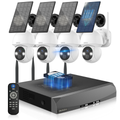Differences Between Video Conferencing Capture Cards and Surveillance Capture Cards
A common question that arises is whether surveillance equipment can be repurposed for video conferencing systems. Given the significant price difference between surveillance devices and dedicated video conferencing cameras, many wonder if these cost-effective surveillance devices are essentially the same as the video conferencing cameras we commonly use. Before addressing this question, let's delve into the technical principles of surveillance and video conferencing systems.
**Principles of Surveillance and Video Conferencing:**
Surveillance systems typically capture data through analog signals from devices like bullet and PTZ cameras. These signals are compressed and stored on hard drives. Video conferencing systems, on the other hand, also use analog signal capture from pan-tilt-zoom (PTZ) cameras. The data is then encoded and transmitted to other clients. While the basic processes are similar, the connection between surveillance devices and video conferencing systems differs due to the type of capture card and interface used.
**Different Types of Capture Cards:**
The term "video capture card" encompasses various types, such as VGA, HDMI, surveillance, streaming media, TV, DVI, and 1394 capture cards. Surveillance-specific capture cards are a subset of video capture cards. They usually feature multiple data interfaces to simultaneously capture multiple video streams. Conversely, the capture cards intended for video conferencing, primarily streaming media capture cards, are designed to capture a single video stream. These cards convert analog signals to digital signals without compression. Therefore, video conferencing capture cards are often referred to as "video software compression cards," whereas surveillance cards perform compression, earning them the title of "video hardware compression cards."
**Interface Differences:**
In terms of interface, surveillance devices typically employ BNC interfaces to connect with capture cards, while video conferencing equipment generally uses AV or HDMI interfaces to link with capture cards. Consequently, surveillance devices cannot connect to the video software compression cards used in video conferencing, and similarly, video conferencing PTZ cameras cannot connect to surveillance cards.
**Implementation and Compression:**
Beyond differences in capture cards and interfaces, video conferencing and surveillance systems differ in terms of system implementation. Surveillance systems usually capture multiple video streams that require real-time compression and recording. Achieving real-time compression for multiple video streams through software alone can be challenging. As a result, surveillance systems use hardware encoding, which supports efficient compression and real-time performance. Some surveillance systems, particularly those with fewer capture channels, also offer support for software encoding. In such cases, video conferencing software compression cards can be used for front-end capture.
Video conferencing systems typically utilize software-based video encoding. However, certain video conferencing systems can also incorporate hardware encoding for real-time data transmission. It's important to note that video conferencing systems often focus on encoding for real-time communication.
In conclusion, while some interchangeability exists between surveillance and video conferencing systems, the distinct purposes and technical requirements of each necessitate dedicated equipment for optimal performance. A **home surveillance camera system with wireless technology and a built-in hard drive** addresses security needs effectively. On the other hand, a **weatherproof wireless security camera system** caters to outdoor environments while ensuring reliable video quality. OHWOAI's wide range of offerings ensures that the right solution can be chosen for the intended purpose, whether it's surveillance or video conferencing.
Sample Block Quote
Nam tempus turpis at metus scelerisque placerat nulla deumantos sollicitudin delos felis. Pellentesque diam dolor an elementum et lobortis at mollis ut risus. Curabitur semper sagittis mino de condimentum.









